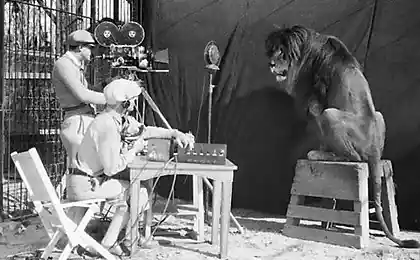1439
The life lived Leo (21 photos)
In Serengeti National Park, in eastern Africa, temnogrivy lion named Sea Battle is a courageous struggle for their place under the sun.
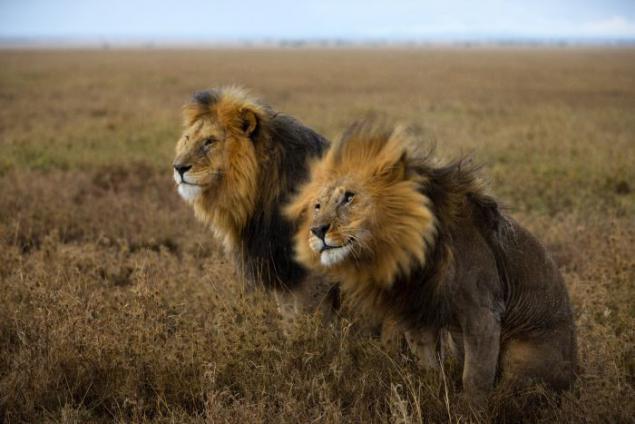
They say a cat has nine lives, but for saying precisely the lions of the Serengeti is not working. Conditions in the region of East Africa are harsh, and the die is much easier than to save lives - the one and only. Adult male lion, if he is lucky and the strong survive in the wild to old age - the age of twelve. Females may live longer - 19 years. But the average life expectancy is much less than the lions - primarily because of the high mortality among cubs, half of which killed up to two years. And even if the lion reaches adulthood, it does not guarantee him a peaceful death. As for a young strong male with a dark mane, which the scientists gave the nickname Sea battle, it seemed that his life ended in the morning August 17, 2009.
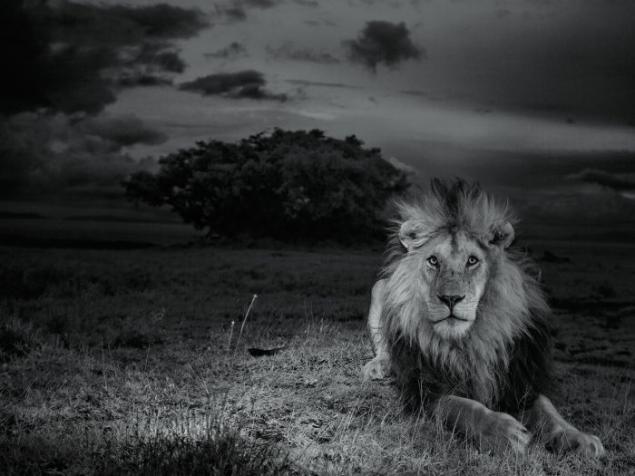
Lions kill each other. In defending its interests, Sea Battle is facing danger every day and every night.
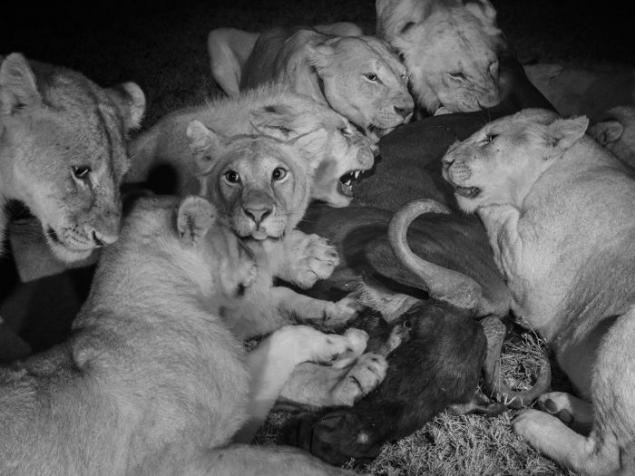
Grown from Pride Vumbi Young and adult female (fifth from left) feast at the carcass wildebeest. Most dark, moonless hours - the best time for hunting, because cats can see in the dark better than their victims. These black and white photographs were taken in infrared light, to as little as possible to disturb the lions.
Ingela Swede Jansson, who worked as an assistant in a long-term project of studying the life of lions, was present at the scene. She was already familiar with C-fight - in fact, it is thanks to her he received the name. According to Jansson, she gave three new cubs "boring" Klitschko alphabetically: Hey, fight, fight and Bi-Cu-fight. Now Sea battle was five years old, and he was part of maturity. Out of the car Jansson saw three males attacked Sea fight. It seemed a lion fight for his life in such a situation is doomed to failure. Watching the fight, Ingela first understood the vital pillars of the local Lions: is the constant threat of death determines the social behavior of these ferocious predators.
"Three Assassins circling around the C-bout and in turn attacked him from behind, they cling to her thighs, bite behind his back, and he spun, spun and snapped, desperately trying to escape.»
The day Jansson came to a dry riverbed Seronera to watch the pride of Jua Kali. In addition, it was interested in adult males, including those living with Pride. (Males do not belong to any Pride and form small groups that control one or more pride. "Resident", as they call these lions scientists, provide the pride not only offspring and protection, and food.) Male resident in the pride Jua -Kali been known Jansson were C-fight and his only friend, zlatogrivy womanizer named Hildur. On reaching the river, Ingela saw in the distance a single male pursued by others. Leo fleeing was Hildur. And from whom he had fled, and why, at first did not understand Jansson.

Sea battle mate with females of the pride Kibumba. Becoming a father, a male resident can be expelled by other males. His young in this case will be killed or thrown - to certain death.
Then she saw another four males. They have settled down a penalty, about five lions away from each other. Jansson recognized them - they were members of another union, self-confident group of young males, which in her field diary has received the code name "The Killers." Reputation they were bad. One of the lions in the lower right canine Alel blood - so recently had a fight. The other crouched and growled continuously. Approaching closer, Jansson could see his dark mane and realized that it was a Sea battle - wounded comrade abandoned and surrounded by three of the killers.

Pride Vumbi resting on a spear - a small stone hill, near his favorite watering hole. Spear for the lions - a place of rest and observation post. In the rainy season, when there is green grass, here come herds of wildebeest.
Also nearby in the grass Jansson saw lactating female - wearing a collar with a beacon of pride lioness Jua Kali. Lactation meant that somewhere nearby lion cubs hiding in the shelter, which was the father of the C-bout and Hildur. Confrontation between Sea fight and murderers were not pointless hassle. It was a battle for control of pride. If the new males will win, they will kill the young of their rivals, and the females soon begin again in heat.
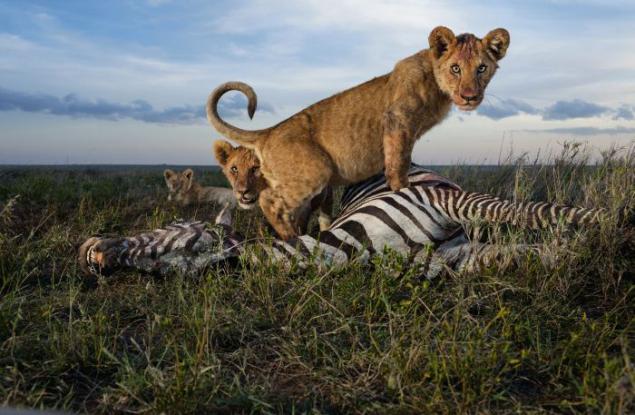
Pride of lion cubs Simba too young to kill, but old enough to want meat. Hunt females and sometimes males. The rainy season is the best production - zebra and wildebeest.
After a few moments battle resumed. Killer circled Sea battle and in turn attacked him from behind, cling to her thighs, bite behind his back, and he spun, spun and snapped, desperately trying to escape. With close so close to it almost did not reach the spray of saliva and smell aggression Jansson fascinated looked out the car window and took pictures. Billowing dust, Sea battle circled on the ground and growled, and the killer jumps, dodging his fangs again attacked him from behind, biting fangs and strikes, while his skin did not seem like an old tattered rag. Jansson thought that watching the last moments of the life of the lion. Even if he did not die of his wounds at once, she decided, he faces a bacterial infection.
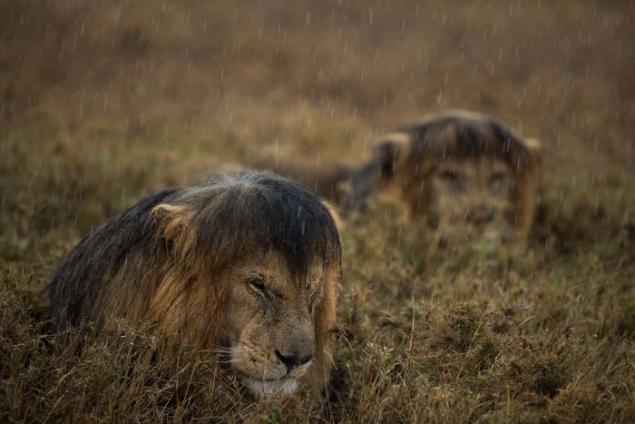
Sea Battle (front) and Hildur lie side by side under the jets afternoon shower in Serengeti National Park. Adult lions form coalitions with other males, often with his brothers. Sea battle and Hildur relatives are not, but their duet for two years.
And then it was over - just as suddenly as it had begun. Fight lasted maybe just a minute. Lions divided. The killers walked away and spread on top of the mound, overlooking the river, and C-bout ran away. He was - is - alive, but defeated.
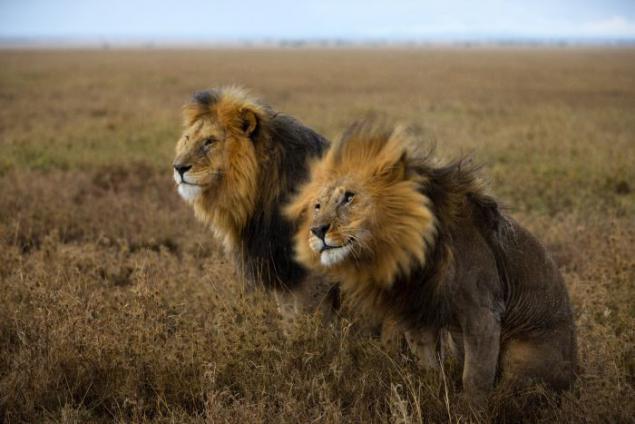
Hildur mane shakes off raindrops. Together with C-fight they control are two pride - Vumbi Simba and East - each of which lives five adult lionesses.
Jansson had not seen him for two months. Perhaps, she thought, the lion has died or is on the verge of death from starvation. Meanwhile, The Killers were attached to Jua Kali Pride. Little cubs, young Sea battle or Hildur disappeared. Most likely, they were killed by adult males, or simply starved, neglected and abandoned by his mother in the lurch. Soon the females in heat started again, and the fathers of their new babies become killers. Sea battle was in the past - cut a slice. Such is the harsh truth of life lion.
Tigers - single. Cougars - loners. None of the leopard does not wish to spend time with a group of other leopards. Of all the felines lions only - really social animals forming alliances males and prides.
But why social behavior, absent from other cats, has become so important to the lions? Maybe it's an evolutionary adaptation was necessary to hunt big game like wildebeest? Or the fact that it makes it easier to protect the offspring? Or it arose because of the need to fight for the territory? Details of the social life of lions began to emerge in the last forty years, and many of the most important discoveries in this field were made in the course of research within a single ecosystem - Serengeti.

Playful lioness 20 months old peremahival through the back Hildur in rainy savanna. This girl - the daughter Hildur or C-fight. Lions give time to his family, patiently demolishing pranks kids, but their main task - to protect the territory from other males.
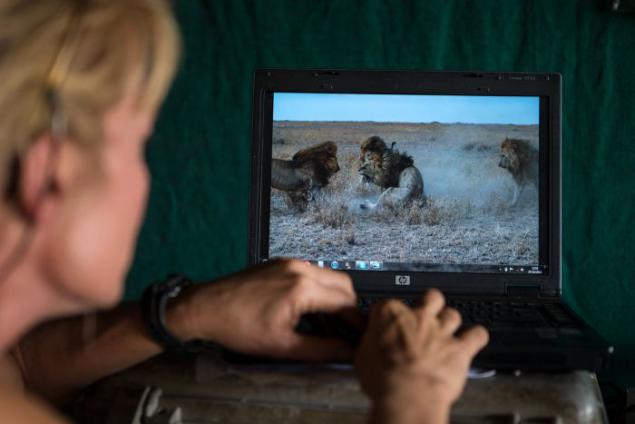
In 2009, a gang of lions, nicknamed murderers attacked the Sea fight. Ingela Jansson, who was then a researcher at the Serengeti Lion Project, pictures of battle. Sea battle survived, but the killer drove him from pride Jua Kali, where he predominated with Hildur.
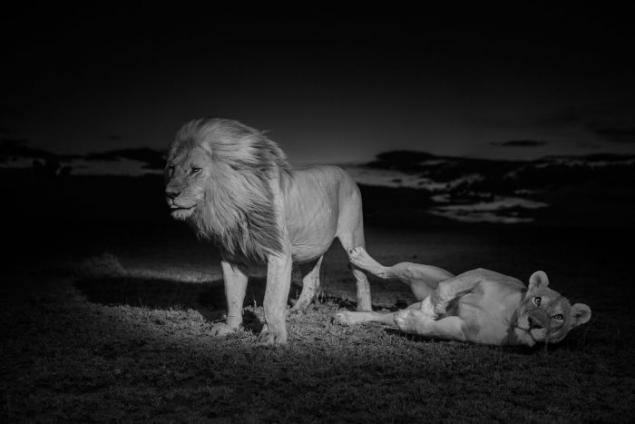
Infrared rays illuminate Hildur and lioness pride of Vumbi vacationing after mating. Sometimes the females produce offspring of pride at the same time. Then the group can together to protect and feed their babies.
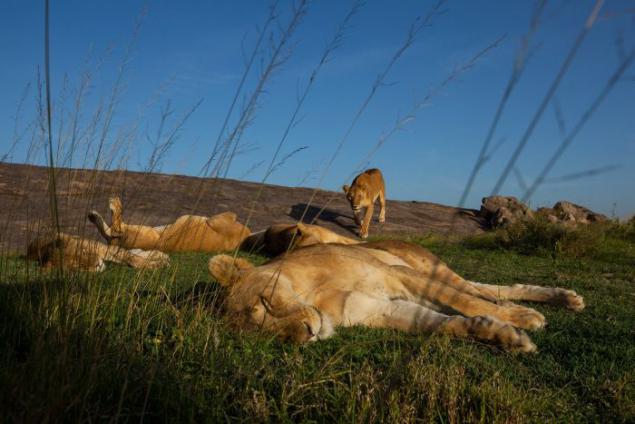
Pride of Lionesses Vumbi staged at siesta favorite body of water. The picture from a low angle has been made robot, which the photographer Nick Nichols worked with the team to shoot cats closeup.
Serengeti National Park - about 14,750 square kilometers of forests and grassy plains near the northern border of Tanzania. In addition to the migrating herds of ungulates, is home to a population, and less prone to wander herbivores: antelopes Bubale topi, eland and impala, reed and water goats, buffaloes, warthogs. Nowhere else in Africa, there is such an abundance of ungulates, and even in open terrain. Therefore, the Serengeti - a perfect place for both predators and those who study them.
Zoologist George Schaller came here in 1966 on the invitation of the Director of National Parks of Tanzania to study the impact of lions on ungulate populations - and in the process learn more about the structure of the entire ecosystem. Eventually replace Schaller came a young Englishman Brian Bertram, who was detained in the Serengeti for four years - enough time to start figuring out what social factors influence the reproductive success and the reasons for such an important thing as killing young male cubs.
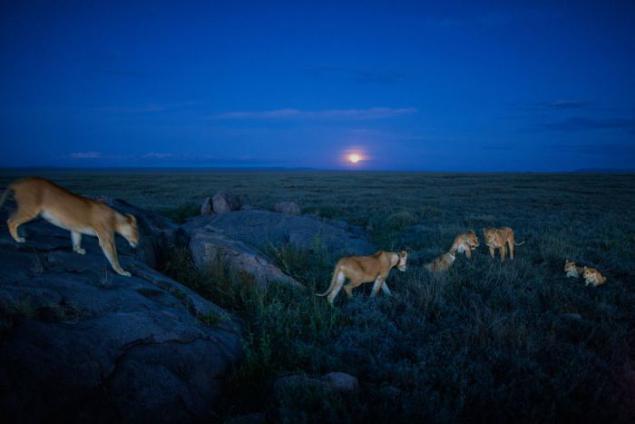
At dusk Pride Vumbi animated. With the rising of the moon Lioness waking up from an afternoon nap, arrange fights in the grass and go for an evening hunt. Nichols took this picture in natural light; Soon he had to switch to infrared photography.
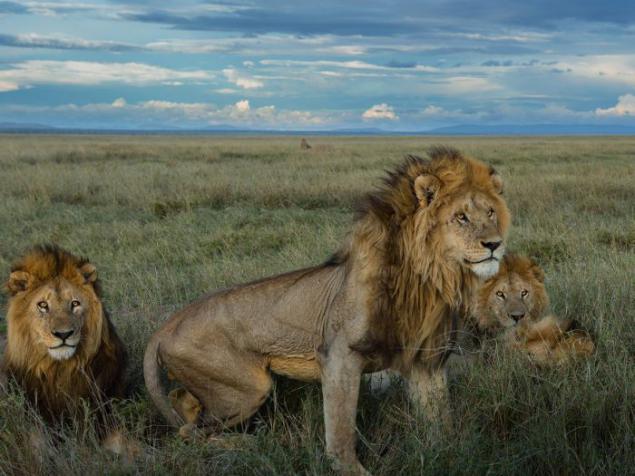
Assassins, a group of four male, got his nickname after a massacre with several females. In addition, they nearly killed his rival Sea fight. Nice area - a precious resource, so that the fight with competitors and their expulsion - a natural part of the struggle for existence.
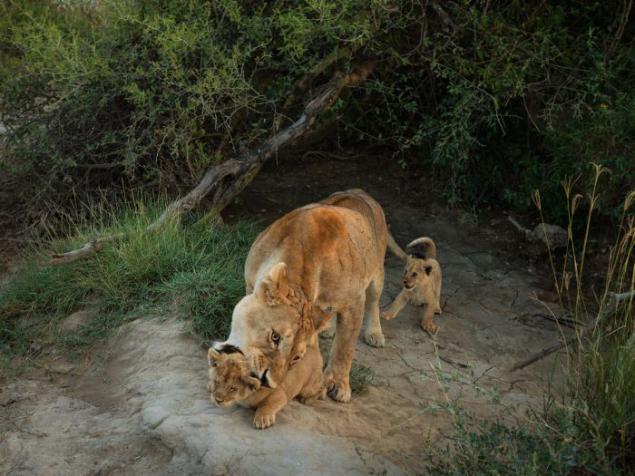
Lioness looks after cubs. In the first few weeks, babies are too young to participate in the general tinkering with the grown cubs pride, and too vulnerable to predators, so that the mother hides them in a secluded den. But these kids will soon have to join the senior.
Then, in 1978, took the baton Craig Packer and Anne Pusey, before working in the research center of Gombe Stream (also in Tanzania). Pewsey watching lions more than a decade and has become a co-author of many scientific papers and Packer still heads the project "Serengeti Lion", which participates Ingela Jansson. Today Packer - the world's most authoritative expert on African lions, their behavior and habitat. If thirty-five years of Packer added to the years that have been here Schaller and the rest, it turns out that the project is "Serengeti Lion" - the longest in the history of the continuous study of any kind in the field. Long project allows scientists to view the events in the broader context and to distinguish temporary from the permanent. "If you have the data for a long period of time - Schaller said to me - you can understand what is happening and what happens in reality».
A case including death. But this time the C-bout survived. After a dramatic meeting with the murderers he renounced claims to pride Jua Kali and went to the east. Hildur, his friend, was useless in difficult times, went with him.
Three years later, that is the time when C-fight I saw it and Hildur took control of two other prides, Simba East and Vumbi whose territories are located on the open plains and spear - as in Africa called outputs of rock to the surface land - south of the Ngara-Nanyuki. It's not the best part of the Serengeti for the Lions, as well as for their production - during the dry season, it can be difficult and hungry - but here Sea battle and Hildur have the opportunity to start life anew.
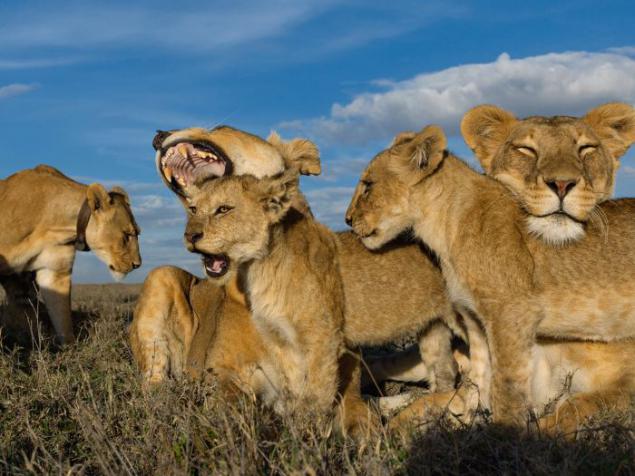
Grown young, these cubs of the pride Vumbi live together in a "manger": the female of the pride, united aim to cultivate a new generation, caring and looked after and their, and others' offspring.
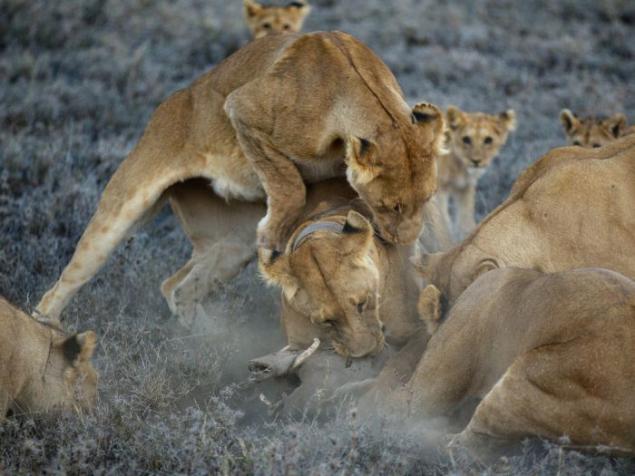
Pride of Lionesses Vumbi (Swahili word meaning "dust") kill warthog, which pulled out of the hole. These small snacks to help survive the difficult dry season, when young may die of hunger.
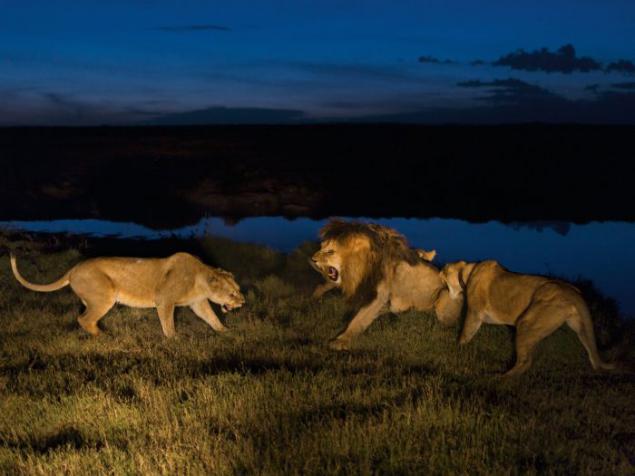
In the dry season it is not easy to account for everything. Nerves lionesses of Pride Vumbi to the limit, they are ready to defend their cubs from anyone, and even snapping at Sea battle, even though he is one of the founding fathers of the residents.
I've traveled to these places in the company of Daniel Rosengren - another adventure lovers from Sweden, who succeeded in the post Ingela Jansson observer lions. Spear, blocks of stone, decorated with trees and bushes, towered over the plains, offering weary exiled lions security, shade and shelter with a good vantage point. In this corner of the park, you can go a few days without seeing a car with tourists. Besides us and fotogruppy Michael Nichols, a few months in the camp is situated at the river bed, there was no one there.
On that day, the radio which sounded headphones Rosengren, called us to spear Zebras. There, in the shadow of the vegetation we found wearing a collar with a beacon of pride Vumbi female. Next to her was a magnificent male with a thick mane that fell on the shoulders and neck, like a velvet cape. It turned out to be the C-bout.

Males seldom give up their privileges. Sea battle feasting on the carcass of a zebra, and the females and young are waiting for distance - stops them porykivanie low warning. Their turn will come later.
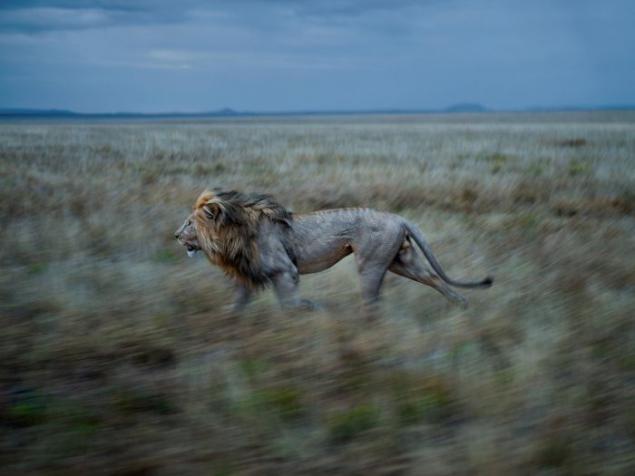
Hildur, Comrade Sea battle, often makes many visits to the territory of Pride Simba East. Union males, controlling two Pride must vigilantly watch over both.
From a distance of only 12 meters, besides looking through binoculars, I could see no trace of the wounds on his sides and thighs. All healed. "The lions - Rosengren told me - most scars disappear after some time, except those near the nose or mouth." Sea battle began a new life in a new place with new Lioness and looked quite prosperity. He became fathers Hildur several litters of cubs. Just last night - so we were told Nichols that he saw it - the females of the pride Vumbi killed eland antelope. This is a very big production, and C-bout put on her royal paw, claiming their right to have first. He ate alone, choosing the best pieces, but not much, and then allowed to come to the carcass lionesses and cubs. Hildur was missing - apparently, was another company technoy female. So these two well settled, enjoying all the privileges of the male resident. But just 12 hours later, we realized that trouble followed them, and to the east.
The next day, early in the morning Rosengren took us out of the camp Nichols to the river in search of Pride Kibumba. Several months ago, thence males vanished - gone in an unknown direction by unknown reasons - and Rosengren was interesting, did not take anyone in their place. It was part of the overall work of the research Packer: to chronicle the appearances and disappearances, births and deaths, unions and expulsions affecting the size of their territory and pride. If Kibumba, new males, who are they? Rosengren There was a suspicion in this respect, and it was confirmed that in the long grass on the bank of the river, we met with the killers.
They were beautiful, these traits - four eight-male resting in a friendly company companions. They looked menacing and smug. Rosengren told me that they may have two pairs of brothers, born in 2004, with a gap of several months. First murderer called them in 2008 another field researcher after came to the conclusion that they killed three females with beacons - one by one - in the watercourse of the river just west of Seronera. Such aggression of males relative to females is not something absolutely abnormal, and in some cases may contribute to survival as frees up space for the pride they control, eliminating the need to compete with females living in the neighborhood. Still, the case brought killers disrepute.
"Even if the vanquished lion perishes in a fierce battle, he will have to go away, bleeding, mutilated and perhaps doomed to a slow death from infection or starvation.»
Although Rosengren and called me their nicknames, he preferred to call these numbers for males: 99, 98, 94 and 93. Indeed, numerals, seemed to correspond more to a sense of the dark threat that comes from these animals. The male 99, who was lying, turned to us in profile, the nose was a Roman senator and dark (although not as dark as that of the C-bout) mane.

They say a cat has nine lives, but for saying precisely the lions of the Serengeti is not working. Conditions in the region of East Africa are harsh, and the die is much easier than to save lives - the one and only. Adult male lion, if he is lucky and the strong survive in the wild to old age - the age of twelve. Females may live longer - 19 years. But the average life expectancy is much less than the lions - primarily because of the high mortality among cubs, half of which killed up to two years. And even if the lion reaches adulthood, it does not guarantee him a peaceful death. As for a young strong male with a dark mane, which the scientists gave the nickname Sea battle, it seemed that his life ended in the morning August 17, 2009.

Lions kill each other. In defending its interests, Sea Battle is facing danger every day and every night.

Grown from Pride Vumbi Young and adult female (fifth from left) feast at the carcass wildebeest. Most dark, moonless hours - the best time for hunting, because cats can see in the dark better than their victims. These black and white photographs were taken in infrared light, to as little as possible to disturb the lions.
Ingela Swede Jansson, who worked as an assistant in a long-term project of studying the life of lions, was present at the scene. She was already familiar with C-fight - in fact, it is thanks to her he received the name. According to Jansson, she gave three new cubs "boring" Klitschko alphabetically: Hey, fight, fight and Bi-Cu-fight. Now Sea battle was five years old, and he was part of maturity. Out of the car Jansson saw three males attacked Sea fight. It seemed a lion fight for his life in such a situation is doomed to failure. Watching the fight, Ingela first understood the vital pillars of the local Lions: is the constant threat of death determines the social behavior of these ferocious predators.
"Three Assassins circling around the C-bout and in turn attacked him from behind, they cling to her thighs, bite behind his back, and he spun, spun and snapped, desperately trying to escape.»
The day Jansson came to a dry riverbed Seronera to watch the pride of Jua Kali. In addition, it was interested in adult males, including those living with Pride. (Males do not belong to any Pride and form small groups that control one or more pride. "Resident", as they call these lions scientists, provide the pride not only offspring and protection, and food.) Male resident in the pride Jua -Kali been known Jansson were C-fight and his only friend, zlatogrivy womanizer named Hildur. On reaching the river, Ingela saw in the distance a single male pursued by others. Leo fleeing was Hildur. And from whom he had fled, and why, at first did not understand Jansson.

Sea battle mate with females of the pride Kibumba. Becoming a father, a male resident can be expelled by other males. His young in this case will be killed or thrown - to certain death.
Then she saw another four males. They have settled down a penalty, about five lions away from each other. Jansson recognized them - they were members of another union, self-confident group of young males, which in her field diary has received the code name "The Killers." Reputation they were bad. One of the lions in the lower right canine Alel blood - so recently had a fight. The other crouched and growled continuously. Approaching closer, Jansson could see his dark mane and realized that it was a Sea battle - wounded comrade abandoned and surrounded by three of the killers.

Pride Vumbi resting on a spear - a small stone hill, near his favorite watering hole. Spear for the lions - a place of rest and observation post. In the rainy season, when there is green grass, here come herds of wildebeest.
Also nearby in the grass Jansson saw lactating female - wearing a collar with a beacon of pride lioness Jua Kali. Lactation meant that somewhere nearby lion cubs hiding in the shelter, which was the father of the C-bout and Hildur. Confrontation between Sea fight and murderers were not pointless hassle. It was a battle for control of pride. If the new males will win, they will kill the young of their rivals, and the females soon begin again in heat.

Pride of lion cubs Simba too young to kill, but old enough to want meat. Hunt females and sometimes males. The rainy season is the best production - zebra and wildebeest.
After a few moments battle resumed. Killer circled Sea battle and in turn attacked him from behind, cling to her thighs, bite behind his back, and he spun, spun and snapped, desperately trying to escape. With close so close to it almost did not reach the spray of saliva and smell aggression Jansson fascinated looked out the car window and took pictures. Billowing dust, Sea battle circled on the ground and growled, and the killer jumps, dodging his fangs again attacked him from behind, biting fangs and strikes, while his skin did not seem like an old tattered rag. Jansson thought that watching the last moments of the life of the lion. Even if he did not die of his wounds at once, she decided, he faces a bacterial infection.

Sea Battle (front) and Hildur lie side by side under the jets afternoon shower in Serengeti National Park. Adult lions form coalitions with other males, often with his brothers. Sea battle and Hildur relatives are not, but their duet for two years.
And then it was over - just as suddenly as it had begun. Fight lasted maybe just a minute. Lions divided. The killers walked away and spread on top of the mound, overlooking the river, and C-bout ran away. He was - is - alive, but defeated.

Hildur mane shakes off raindrops. Together with C-fight they control are two pride - Vumbi Simba and East - each of which lives five adult lionesses.
Jansson had not seen him for two months. Perhaps, she thought, the lion has died or is on the verge of death from starvation. Meanwhile, The Killers were attached to Jua Kali Pride. Little cubs, young Sea battle or Hildur disappeared. Most likely, they were killed by adult males, or simply starved, neglected and abandoned by his mother in the lurch. Soon the females in heat started again, and the fathers of their new babies become killers. Sea battle was in the past - cut a slice. Such is the harsh truth of life lion.
Tigers - single. Cougars - loners. None of the leopard does not wish to spend time with a group of other leopards. Of all the felines lions only - really social animals forming alliances males and prides.
But why social behavior, absent from other cats, has become so important to the lions? Maybe it's an evolutionary adaptation was necessary to hunt big game like wildebeest? Or the fact that it makes it easier to protect the offspring? Or it arose because of the need to fight for the territory? Details of the social life of lions began to emerge in the last forty years, and many of the most important discoveries in this field were made in the course of research within a single ecosystem - Serengeti.

Playful lioness 20 months old peremahival through the back Hildur in rainy savanna. This girl - the daughter Hildur or C-fight. Lions give time to his family, patiently demolishing pranks kids, but their main task - to protect the territory from other males.

In 2009, a gang of lions, nicknamed murderers attacked the Sea fight. Ingela Jansson, who was then a researcher at the Serengeti Lion Project, pictures of battle. Sea battle survived, but the killer drove him from pride Jua Kali, where he predominated with Hildur.

Infrared rays illuminate Hildur and lioness pride of Vumbi vacationing after mating. Sometimes the females produce offspring of pride at the same time. Then the group can together to protect and feed their babies.

Pride of Lionesses Vumbi staged at siesta favorite body of water. The picture from a low angle has been made robot, which the photographer Nick Nichols worked with the team to shoot cats closeup.
Serengeti National Park - about 14,750 square kilometers of forests and grassy plains near the northern border of Tanzania. In addition to the migrating herds of ungulates, is home to a population, and less prone to wander herbivores: antelopes Bubale topi, eland and impala, reed and water goats, buffaloes, warthogs. Nowhere else in Africa, there is such an abundance of ungulates, and even in open terrain. Therefore, the Serengeti - a perfect place for both predators and those who study them.
Zoologist George Schaller came here in 1966 on the invitation of the Director of National Parks of Tanzania to study the impact of lions on ungulate populations - and in the process learn more about the structure of the entire ecosystem. Eventually replace Schaller came a young Englishman Brian Bertram, who was detained in the Serengeti for four years - enough time to start figuring out what social factors influence the reproductive success and the reasons for such an important thing as killing young male cubs.

At dusk Pride Vumbi animated. With the rising of the moon Lioness waking up from an afternoon nap, arrange fights in the grass and go for an evening hunt. Nichols took this picture in natural light; Soon he had to switch to infrared photography.

Assassins, a group of four male, got his nickname after a massacre with several females. In addition, they nearly killed his rival Sea fight. Nice area - a precious resource, so that the fight with competitors and their expulsion - a natural part of the struggle for existence.

Lioness looks after cubs. In the first few weeks, babies are too young to participate in the general tinkering with the grown cubs pride, and too vulnerable to predators, so that the mother hides them in a secluded den. But these kids will soon have to join the senior.
Then, in 1978, took the baton Craig Packer and Anne Pusey, before working in the research center of Gombe Stream (also in Tanzania). Pewsey watching lions more than a decade and has become a co-author of many scientific papers and Packer still heads the project "Serengeti Lion", which participates Ingela Jansson. Today Packer - the world's most authoritative expert on African lions, their behavior and habitat. If thirty-five years of Packer added to the years that have been here Schaller and the rest, it turns out that the project is "Serengeti Lion" - the longest in the history of the continuous study of any kind in the field. Long project allows scientists to view the events in the broader context and to distinguish temporary from the permanent. "If you have the data for a long period of time - Schaller said to me - you can understand what is happening and what happens in reality».
A case including death. But this time the C-bout survived. After a dramatic meeting with the murderers he renounced claims to pride Jua Kali and went to the east. Hildur, his friend, was useless in difficult times, went with him.
Three years later, that is the time when C-fight I saw it and Hildur took control of two other prides, Simba East and Vumbi whose territories are located on the open plains and spear - as in Africa called outputs of rock to the surface land - south of the Ngara-Nanyuki. It's not the best part of the Serengeti for the Lions, as well as for their production - during the dry season, it can be difficult and hungry - but here Sea battle and Hildur have the opportunity to start life anew.

Grown young, these cubs of the pride Vumbi live together in a "manger": the female of the pride, united aim to cultivate a new generation, caring and looked after and their, and others' offspring.

Pride of Lionesses Vumbi (Swahili word meaning "dust") kill warthog, which pulled out of the hole. These small snacks to help survive the difficult dry season, when young may die of hunger.

In the dry season it is not easy to account for everything. Nerves lionesses of Pride Vumbi to the limit, they are ready to defend their cubs from anyone, and even snapping at Sea battle, even though he is one of the founding fathers of the residents.
I've traveled to these places in the company of Daniel Rosengren - another adventure lovers from Sweden, who succeeded in the post Ingela Jansson observer lions. Spear, blocks of stone, decorated with trees and bushes, towered over the plains, offering weary exiled lions security, shade and shelter with a good vantage point. In this corner of the park, you can go a few days without seeing a car with tourists. Besides us and fotogruppy Michael Nichols, a few months in the camp is situated at the river bed, there was no one there.
On that day, the radio which sounded headphones Rosengren, called us to spear Zebras. There, in the shadow of the vegetation we found wearing a collar with a beacon of pride Vumbi female. Next to her was a magnificent male with a thick mane that fell on the shoulders and neck, like a velvet cape. It turned out to be the C-bout.

Males seldom give up their privileges. Sea battle feasting on the carcass of a zebra, and the females and young are waiting for distance - stops them porykivanie low warning. Their turn will come later.

Hildur, Comrade Sea battle, often makes many visits to the territory of Pride Simba East. Union males, controlling two Pride must vigilantly watch over both.
From a distance of only 12 meters, besides looking through binoculars, I could see no trace of the wounds on his sides and thighs. All healed. "The lions - Rosengren told me - most scars disappear after some time, except those near the nose or mouth." Sea battle began a new life in a new place with new Lioness and looked quite prosperity. He became fathers Hildur several litters of cubs. Just last night - so we were told Nichols that he saw it - the females of the pride Vumbi killed eland antelope. This is a very big production, and C-bout put on her royal paw, claiming their right to have first. He ate alone, choosing the best pieces, but not much, and then allowed to come to the carcass lionesses and cubs. Hildur was missing - apparently, was another company technoy female. So these two well settled, enjoying all the privileges of the male resident. But just 12 hours later, we realized that trouble followed them, and to the east.
The next day, early in the morning Rosengren took us out of the camp Nichols to the river in search of Pride Kibumba. Several months ago, thence males vanished - gone in an unknown direction by unknown reasons - and Rosengren was interesting, did not take anyone in their place. It was part of the overall work of the research Packer: to chronicle the appearances and disappearances, births and deaths, unions and expulsions affecting the size of their territory and pride. If Kibumba, new males, who are they? Rosengren There was a suspicion in this respect, and it was confirmed that in the long grass on the bank of the river, we met with the killers.
They were beautiful, these traits - four eight-male resting in a friendly company companions. They looked menacing and smug. Rosengren told me that they may have two pairs of brothers, born in 2004, with a gap of several months. First murderer called them in 2008 another field researcher after came to the conclusion that they killed three females with beacons - one by one - in the watercourse of the river just west of Seronera. Such aggression of males relative to females is not something absolutely abnormal, and in some cases may contribute to survival as frees up space for the pride they control, eliminating the need to compete with females living in the neighborhood. Still, the case brought killers disrepute.
"Even if the vanquished lion perishes in a fierce battle, he will have to go away, bleeding, mutilated and perhaps doomed to a slow death from infection or starvation.»
Although Rosengren and called me their nicknames, he preferred to call these numbers for males: 99, 98, 94 and 93. Indeed, numerals, seemed to correspond more to a sense of the dark threat that comes from these animals. The male 99, who was lying, turned to us in profile, the nose was a Roman senator and dark (although not as dark as that of the C-bout) mane.
Best photos 2013 to TIME magazine
15 animals, which have played an important role in the history of mankind (26 photos)







